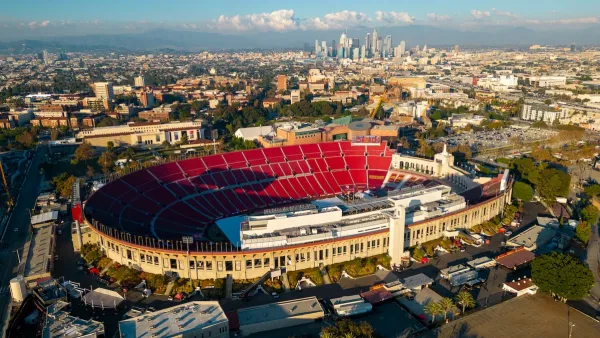Los Angeles Mayor Antonio Villaraigosa's plan to cram 30 years of transit projects into one decade is gathering steam in Washington -- and other cities are watching closely.
"The Mayor has argued his case persuasively, emphasizing the project's environmental and economic significance along with its mobility and livability benefits for Angelenos. The transit expansion itself, even if not accelerated, has much to recommend it: 200 million fewer driving miles annually, 570,000 fewer pounds of emissions annually, and 80 million more transit trips each year. If accelerated, the plan would create 170,000 construction jobs over ten years, contributing to the economic recovery of a county with almost 600,000 unemployed workers. Additionally, 30/10 would save $3.8 billion by avoiding cost inflation already calculated into the transportation plan's price tag while steering clear of the nasty parochial disputes that can derail a project when a transit system is expanded in piecemeal fashion. Finally, the Los Angeles County Economic Development Corporation estimates that the non-accelerated transit expansion would increase federal tax revenue by $2 billion, state tax revenue by $800 million, and local government revenue by $60 million over 30 years. An accelerated plan would likely have a similar fiscal impact but more quickly, providing revenue at a time when cash-strapped governments are starved for resources."
One of the most important elements of this plan is that is proposes to be revenue-neutral for the federal government.
FULL STORY: L.A. Gets Moving on Transit

National Parks Layoffs Will Cause Communities to Lose Billions
Thousands of essential park workers were laid off this week, just before the busy spring break season.

Retro-silient?: America’s First “Eco-burb,” The Woodlands Turns 50
A master-planned community north of Houston offers lessons on green infrastructure and resilient design, but falls short of its founder’s lofty affordability and walkability goals.

Delivering for America Plan Will Downgrade Mail Service in at Least 49.5 Percent of Zip Codes
Republican and Democrat lawmakers criticize the plan for its disproportionate negative impact on rural communities.

Test News Post 1
This is a summary

Test News Headline 46
Test for the image on the front page.

Balancing Bombs and Butterflies: How the National Guard Protects a Rare Species
The National Guard at Fort Indiantown Gap uses GIS technology and land management strategies to balance military training with conservation efforts, ensuring the survival of the rare eastern regal fritillary butterfly.
Urban Design for Planners 1: Software Tools
This six-course series explores essential urban design concepts using open source software and equips planners with the tools they need to participate fully in the urban design process.
Planning for Universal Design
Learn the tools for implementing Universal Design in planning regulations.
EMC Planning Group, Inc.
Planetizen
Planetizen
Mpact (formerly Rail~Volution)
Great Falls Development Authority, Inc.
HUDs Office of Policy Development and Research
NYU Wagner Graduate School of Public Service




























